by Rajan P. Parrikar
First published on SAWF on April 29, 2002
Part 1 | Part 2
On this page we address Bhairavi’s manifestation in many other forms prevalent in Hindustani music.
Pandit Ramashreya Jha “Ramrang” has put together a special Bhairavi Baithak. In this remarkable session recorded in May 2002 at his home in Allahabad, he ranges over several compositions of varied design and genre, traditional and self-composed. To me this shall forever remain an example of Ramrang’s overwhelming love and kindness especially in light of his fragile health at the time. When I said I was doing a feature on Bhairavi and that I would like his input, he at once recorded a session himself and mailed me the tape. The recording was made with very basic equipment, hence the quality of the audio is not as good as we would have liked. Nevertheless, what a priceless document!
Several items in this pool have been published in Jha-sahab’s 5th volume of Abhinava Geetanjali. His presentation here is prototypic, not in the manner of a full concert-style rendition. The intention is solely to illustrate and illuminate the underlying raga features. The highlights include Jha-sahab’s exhibition of uccharana and gestures germane to the genre under review; pertinent remarks punctuate the proceedings.
Bhairavi Baithak
by
Ramashreya Jha “Ramrang”
Jha-sahab opens with a traditional dhrupad in praise of Lord Shiva: bhasma anga Gori sanga.
Ramrang’s own khayal: Bhairavi Bhavani devi.
Switching tracks, Jha-sahab takes on the dadra: naina lage.
Another dadra in Sindh Bhairavi, this one set to Keherwa: na ja balama pardeswa.
The next several items are based in the thumri genre.
Jha-sahab opens with a vilambit thumri, pausing to touch upon the antecedents of this class: rasiya raina ga’i.
This older form of thumri, known as bandish-ki-thumri, is Ramrang’s own composition: ma’i re muraliyan.
Next in line are two compositions, both bandish-ki-thumri, of the renowned thumri composer “Lalan Piya.”
Lalan Piya (c.1850-1927) was the nom de plume of Nandalal Sharma of Farrukhabad. In his book, Indian Music, Thakur Jaideva Singh writes: “…In the later half of the nineteenth century, a movement of composing thumaris on the pattern of gats of instrumental music like sitar or sarod had started. These thumaris were mostly of fast tempo. There were some good composers of this type of thumari. None, however, surpassed Lalan Piya in the composition of such thumaris…His compositions were of such svelte, rhythmic variations that it was difficult for a tabla accompanist to catch the sam. He composed hundreds of thumaris. They were all of bandish (well-set improvised) pattern and in medium or fast tempo. They were mostly on the pattern of gats (fast instrumental compositions) of sitar…Some texts of his thumaris are extraordinary from another point of view. For instance, some of his thumaris are ‘onthabanda’ i.e., none of the words of such a thumari is labial. Such thumaris are not merely padding of words. They have also beautiful poetic content...”
Jha-sahab presents “Lalan Piya.”
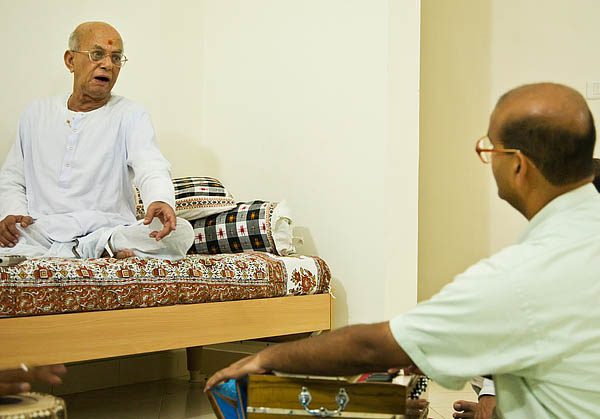
Ramamshreya Jha “Ramrang” and the author in Goa
A different build, this time set to Addha tala: Nandlala daro gulaal.
The next two thumri selections are taken “madhyam se” (i.e. with the tonic is shifted to madhyam).
First, Kunwar Shyam’s rachana: suno suno ji na daro.
This “madhyam se” thumri is a composition of Jha-sahab’s guru Bholanath Bhatt whose adopted colophon was “Das Shyam” (see A Tale of Two Malhars for more on Bholanath Bhatt): jina javi ji aaja ko’u.
Ramrang introduces another genre, the tappa.
The Bhairavi Baithak concludes with a bhajan of Kabir: ya bidha mana ko.
Jha-sahab‘s parting remarks concludes this baithak.
Pandit Bhatkhande was a composer of great merit. Parveen Sultana amplifies on his famous sadra: Bhavani dayani. [Update: Dr. V.N. Muthukumar informs that according to Inder Kishore, this composition is attributed to Anand Kishore Singh of the Betia dhrupad tradition. I need to confirm this.]
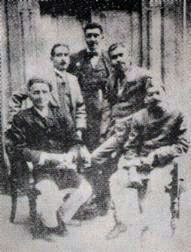
(L-R): V.N. Bhatkhande, Shankarrao
Karnad, Bhalchandra Sukthankar,
Brijkishan Koul, Rai Umanath
Bali
Bhairavi’s looming presence in the Indian musical mind is in no small measure on account of its nexus with the land’s religious and spiritual repertoire. No bhajani baithak can be complete without a generous dose of Bhairavi. Sample an early Bhimsen Joshi rendering this Hari bhajan: jo bhaje Hari ko sada.
Bhairavi lends itself well to brisk, taut bandishes. Exemplifying this type of composition is a bandish of Tassaduq Hussain Khan “Vinodpiya” (1879-1940) rendered by Jitendra Abhisheki: payaliyan baje re.
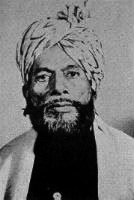
Mushtaq Hussain Khan
Of similar vintage is this old, well-worn cheez dealt by Shaila Datar: dekho mori churiyan.
The American khayal vocalist Shri Warren Senders has earned for himself the sobriquet “Bostonbuwa.” In this recording of a Mumbai mehfil, Bostonbuwa unleashes a tarana.
From tarana it is a hop and skip to tappa for which Bhairavi is fertile ground. First, the Rampur-Sahaswan buzurg Mushtaq Hussain Khan.
Among the current crop, Malini Rajurkar is the reigning tappa specialist.
Tappa was dear to the Gwalior elders. Three marvelous instances of Krishnarao Shankar Pandit are attached.
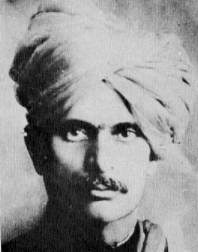
Krishnarao Shankar Pandit
The first is a younger KRSP at the peak of his powers.
The next two are unpublished items of a later KRSP.
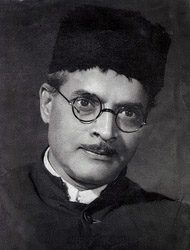
Govindrao Tembe
The nanga Emperor Ali Akbar Khan recently spent quality time pissin’ & partyin’ in his San Rafael swamp on the occasion of his 80th birthday (Happy Birthday, Alu! Pssssst, time to now dispatch you to the knackers). Mr Alubhai has let the grass grow under his sarod for years (it is now perhaps longer than the hair coming out of his ears). Long ago, before he went to the winds, Alumeister had the capacity for a good Bhairavi. Here we must make do with a ho-hum effort.
The swarasmith par excellence, perhaps the greatest Hindustani instrumentalist of the past 50 years – Bismillah Khan – reminds us of the good ol’ festive times in India.
Abdul Halim Jaffer Khan never quite got the recognition he deserved as a sitar player of high class. He breaks a few squares with Sindhu Bhairavi-esque variations.
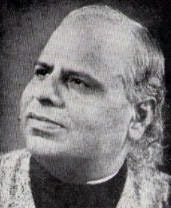
Omkarnath Thakur
Listening to harmonium solos for over 3 minutes is pure torture no matter how adept the player. But Govindrao Tembe was special. His abilities touched a wide range of artistic activity: author, playwright, actor, composer and musician. Govindrao’s wizardry on the harmonium was admired even by the likes of Alladiya Khansaheb and Kesarbai Kerkar. This scratchy 78 rpm reveals why.
We now turn to the thumri anga material. At the head of the line is Bade Ghulam Ali Khan. This rare, unpublished instance finds him engaged in an informal session, playing with the Bhairavi bag of tricks.
This classic BGAK recording is more familiar: naina more tarase.
Rasoolan Bai is enchanting in this cut. Notice the thumri-induced shuddha nishad mentioned earlier by Jha-sahab.
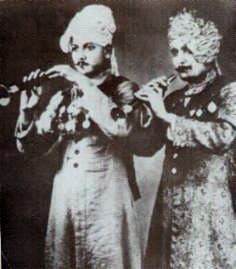
Bismillah Khan with brother Shamsuddin
A bandish-ki-thumri, courtesy Vasantrao Deshpande.
Abdul Karim Khan‘s jamuna ke teer, among the nation’s cultural treasures.
A promising student of Omkarnath Thakur and Balkrishnabuwa Kapileshwari (Abdul Karim Khan’s direct disciple), Yeshwantrai Purohit‘s was a life cut short. His manner exudes vestiges of Abdul Karim Khan.
Kesarbai Kerkar‘s old recording in Raga Bhairavi represents India’s music on the plaque carried aboard NASA’s Voyager spacecraft that is now coasting in the desolate vastness of interstellar space. It is a magnificent performance: jaata kahan ho.
Mallikarjun Mansur takes off his high brow hat for a change.
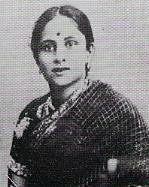
Anjanibai Malpekar
The pièce de résistance of the thumri round – a recording of Anjanibai Malpekar administering taleem to Begum Akhtar.
Anjanibai Malpekar (1883-1974) from Goa – not to be confused with the Agra vocalist, Anjanibai Lolienkar, also from Goa – trained under Nazir Khan, one of the founders of the Bhendibazar Gharana (the others being Chajju Khan and Khadim Hussain Khan). Anjanibai was known in her day for both for her musical gifts and her uncommon beauty. Kishori Amonkar, currently the greatest living Hindustani musician, had the privilege of being tutored by Anjanibai. In Between Two Tanpuras, Vamanrao Deshpande has this passage: “…Another of Kishori’s gurus was Anjanibai Malpekar. Anjanibai loved Kishori dearly, especially because of her great musical talent. She often said to Kishori, “In you, your mother has given birth to a real gem. Go and tell your mother that I said this.” Tonal sensitivity was something Kishori was born with. But she goes to great lengths to admit that her enchanting glide (meend) was taught to her by Anjanibai…”
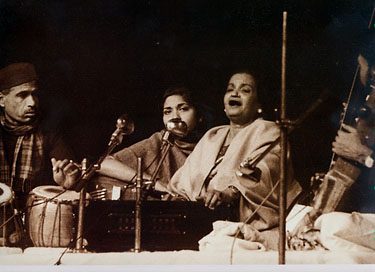
Begum Akhtar
The senior Dagar brothers, N. Moinuddin and N. Aminuddin.
Meerabai‘s entreaty in mat ja jogi is renewed by Omkarnath Thakur, in what is surely among the most memorable Bhairavis.
We rein in these peregrinations with the celebrated lament that has become synonymous with Bhairavi. Wajid Ali Shah, engulfed in wrenching grief, famously cried babul mora naihara chhooto jay (see Appendix at the end of this essay). Scores of musicians have clocked in their versions keeping alive the memory of Wajid Ali’s acute distress.
Khadim Hussain Khan of Agra.
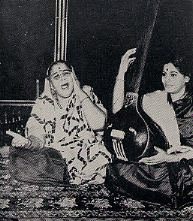
Siddheshwari Devi
“Aftab-e-Mousiqui” Faiyyaz Hussain Khan.
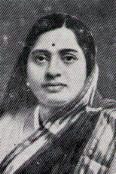
Kesarbai Kerkar
Our odyssey concludes with the supreme Bhairavi rendition of our age, among the finest pieces of recorded music in human history. K.L. Saigal‘s performance has earned the imprimatur and unvarnished admiration of the greatest classical masters, and it has for decades seized the imagination of every lay Indian. This recording from STREET SINGER (1938) is one of the reasons why, in Bertrand Russell’s words, “the human race is worth preserving.”
Upon Saigal-sahab’s babul mora no human voice can improve.
It has been a pleasure and a privilege to bring to you these set of notes. Men of the calibre of Pandit Vishnu Narayan Bhatkhande – with their telescopic vision, capacity for sadhana, keen intellect, and ability to effect positive social change – come by very infrequently. Between these instances of great men are longer periods when humbler hands must remain ceaselessly at work nurturing and keeping the flame of raga burning. And so, “to these serving hands mine also shall belong.”
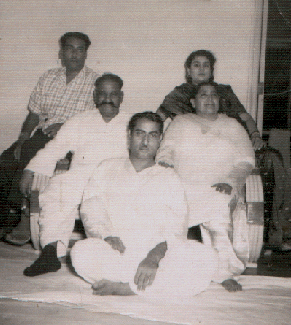
Bade Ghulam Ali Khan with his family
Acknowledgements
I am indebted to Romesh Aeri for his steady support and for allowing me unrestricted access to his vast holdings. The assistance of Ashok Ambardar and Ajay Nerurkar has been both valuable and critical. Sir Vish Krishnan is peerless in his knowledge and prehensile understanding of the diverse genres in India’s music mosaic. The challenge for me was to pare the enormous amount of material he repeatedly deposited at my door.
Special thanks to Prashanth Sharangapani, Ajit Akolkar, Guri Singh, V.N. Muthukumar and Shubha Mudgal. Dhananjay Naniwadekar supplied an important recording for this feature.
This effort would not have gone beyond a couple of installments had it not been for Anita Thakur‘s unswerving dedication to the cause.
[1] Read more about Pandit Vishnu Narayan Bhatkhande.
[2] Read more about Wajid Ali Shah and ‘Babul Mora‘.
[3] Read more about K.L. Saigal.
Part 1 | Part 2
